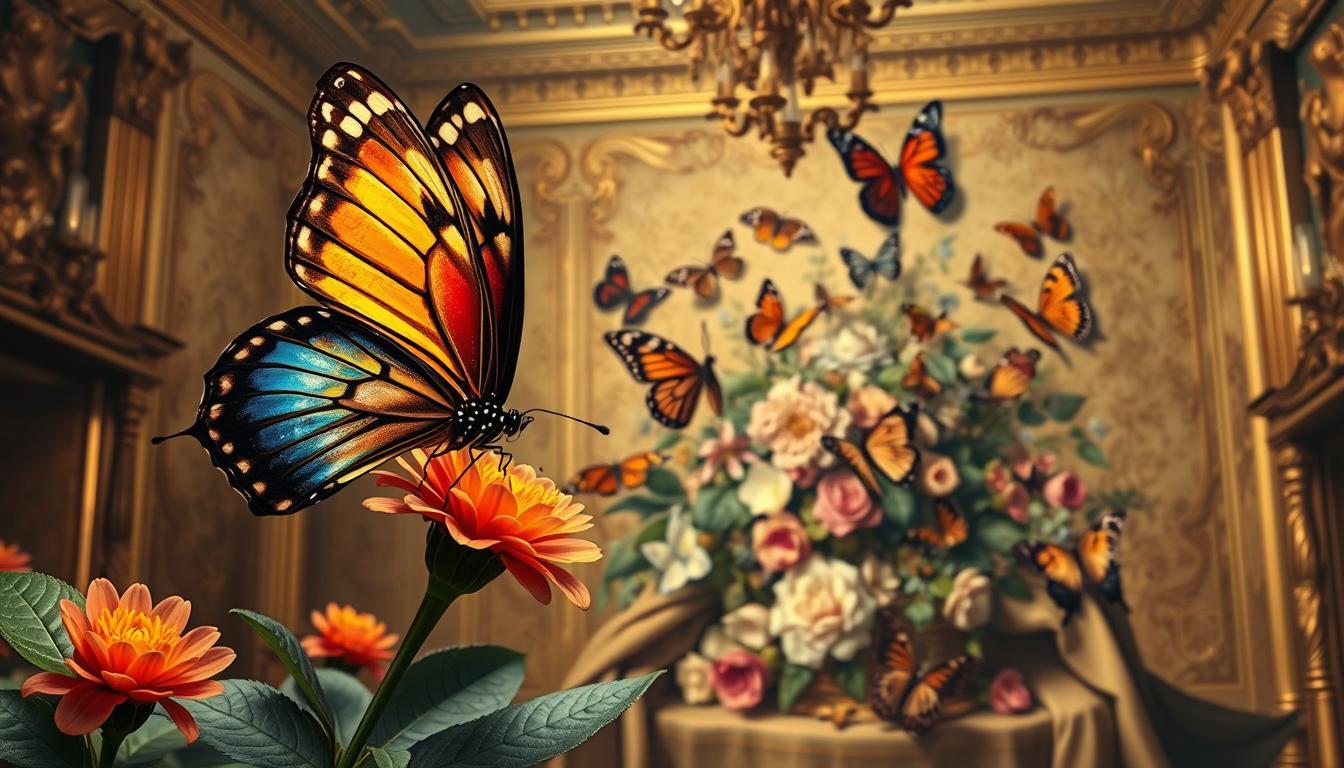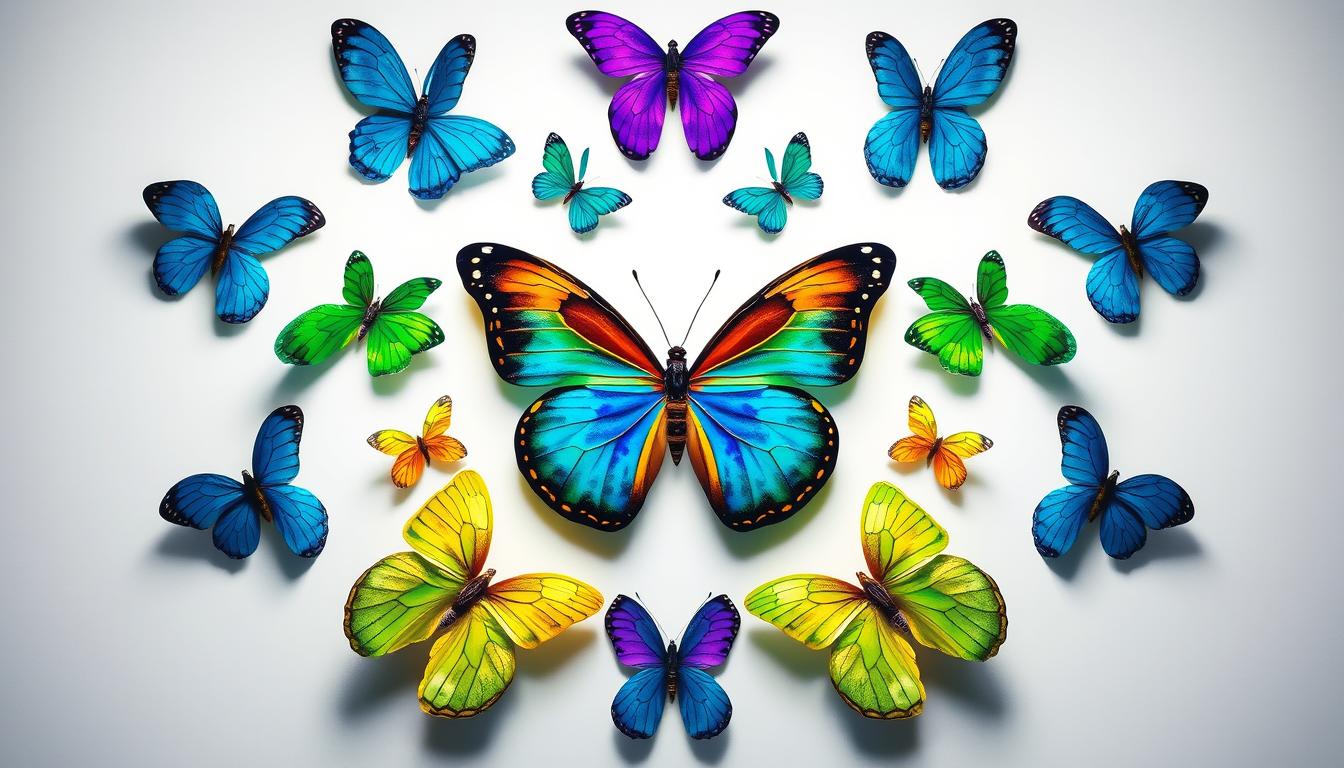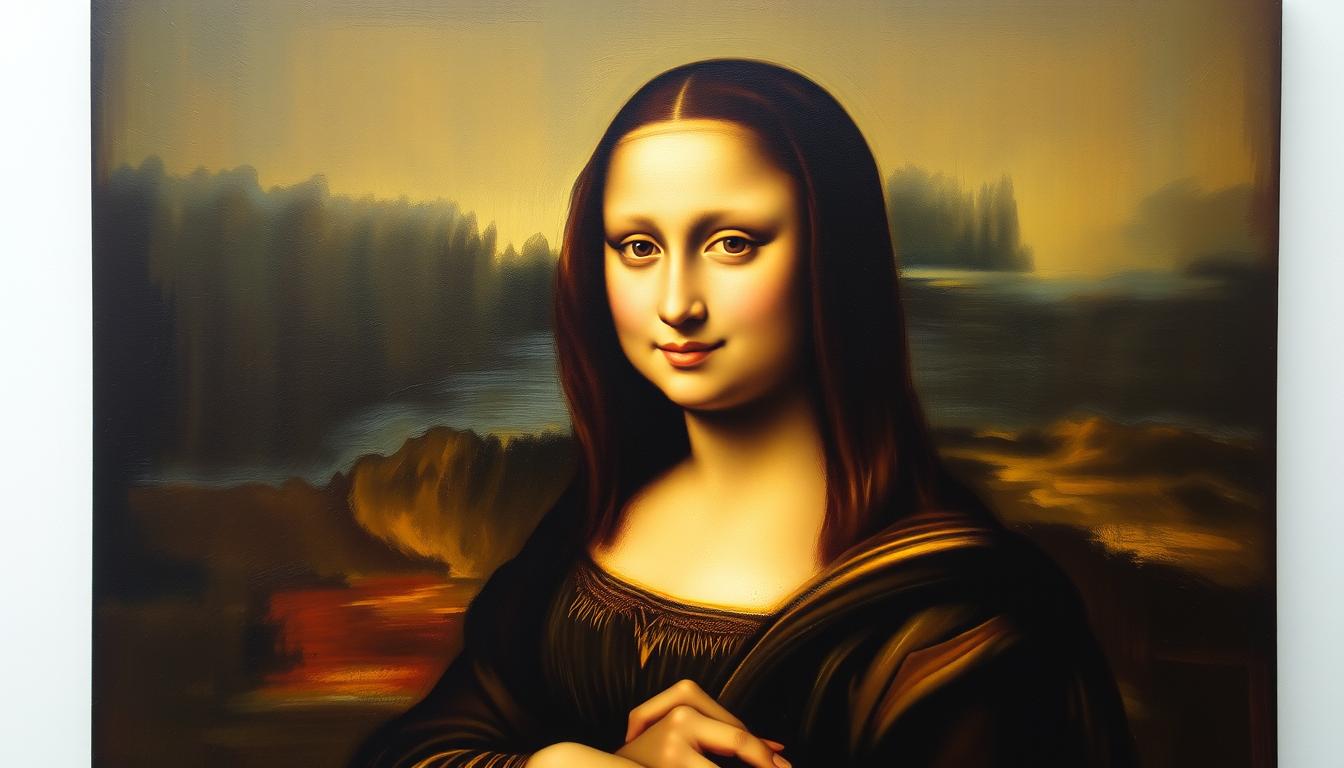Artists often use the butterfly as a clear, visual cue of change and renewal. The motif traces back to Ancient Greek language where psyche meant both “soul” and “butterfly.” That overlap seeded a long association with spirit, inner life, and transformation.
In art, a butterfly can signal rebirth, fleeting beauty, or the fragile edge of life. Meanings shift by culture and context, so the same small creature can feel hopeful or mournful depending on placement, color, and style.

Across studios and galleries, painters—historic and modern—use this motif to explore identity, renewal, and the passage of time. Ahead, we will unpack color choices, cultural roots, and examples that show how a single winged form can change the story a painting tells.
Key Takeaways
- The phrase "What do butterflies symbolize in paintings?" guides the main search intent of this article.
- Butterfly imagery often links to transformation, the soul, and renewal.
- Context, color, and placement shape whether the motif reads as hope or fragility.
- Historical roots, like the Greek psyche, give the symbol deep meaning.
- Both classical masters and contemporary artists use the motif in diverse ways.
- Viewers bring personal meaning, so interpretations vary with experience.
Butterflies in art today: why the symbol still matters
Across galleries and feeds, a small winged form now carries big messages about nature and our choices.
Present-day artists link that visual shorthand to environmental care, spiritual growth, and cultural memory. SN’s photographs arm models as protectors, then strip color from the scene so only the blues and yellows of the butterfly wings remain. That selective hue turns a pretty motif into a clear warning and a call to stewardship.
Present-day relevance: environmental, spiritual, and cultural resonance
Many creators use butterfly imagery to suggest renewal, change, and fragile balance. David Kracov’s sculptures, for example, celebrate movement and small acts that ripple across the world. That idea—tiny shifts producing broad effects—resonates in climate conversations and personal transformation practices alike.
From galleries to social feeds: how butterfly imagery travels
Bright patterns and clear forms travel fast online. A single image can spark inspiration, invite shared meaning, and link gallery walls with daily feeds. Whether evoking freedom, joy, or urgent caution, this motif helps artists communicate complex ideas with simple, uplifting visuals.
- Selective color highlights what needs protection.
- Bold wings offer quick recognition and social reach.
- Works balance beauty with urgency about biodiversity.
Roots of the symbol: from psyche to painting
Ancient language and local lore stitched wings to spirit long before painters borrowed the image.
In Ancient Greek thought the word psyche meant both “soul” and “butterfly.” This double meaning fused the insect with human inner life and gave artists a ready metaphor for spiritual change.
Ancient Greek psyche: butterfly and soul intertwined
The Greek link between psyche and soul helped scholars and painters treat the winged form as an emblem of inner movement and metamorphosis.
Folklore and faith: Ireland’s protection of white butterflies as children’s souls
By the 17th century, Irish custom forbade harming white butterflies because many believed they were the souls of lost children. That rule shows how folk faiths protected the motif and made it sacred in daily life.
These linguistic and folkloric roots moved into manuscripts, decorative arts, and canvases. Artists placed a small butterfly near figures to hint at ascent, inner life, or the passing of a period in a subject’s story.
- Greek language: gave the motif philosophical weight.
- Irish folklore: made the white form a protected symbol of souls.
- Artistic adoption: painters borrowed these meanings to suggest metamorphosis and life’s passage.
| Source | Belief | Impact on art |
|---|---|---|
| Ancient Greece | psyche = soul and butterfly | Provided a linguistic foundation for spiritual motifs |
| 17th‑century Ireland | White butterflies seen as children’s souls | Reinforced sacred status; influenced everyday iconography |
| Medieval to Renaissance Europe | Folk and church tales layered meanings | Appeared in manuscripts, altarpieces, and decorative crafts |
For more on how animal imagery became part of artistic language, see this short resource on butterfly symbolism.
Core meanings in paintings: transformation, life, and the passage of time
Painters use stages of the insect’s life cycle to narrate personal journeys and social shifts. Small details—an egg on a leaf, a cocoon, a fresh wing—map a path from growth to renewal. These images let viewers read complex change at a glance.
Metamorphosis and rebirth: from caterpillar to new form
Metamorphosis is shown literally: egg, caterpillar, chrysalis, imago. Artists use that arc to promise rebirth and personal transformation.
Van Gogh and others used moths and butterfly figures to suggest human potential for change and rebirth.
Hope, freedom, and joy versus fragility and impermanence
Light palettes, raised wings, and open space signal hope, freedom, and joy. Yet thin wings, faded pigment, or a single fallen form warn of brevity and loss.
Life, death, and endurance: how time is pictured on the wings
Some painters, like Damien Hirst, layer butterflies to question appearance and endurance. Repeated forms suggest cycles that resist a simple end.
- Single butterfly: individual change.
- Swarm: collective flux and social change.
- Damaged wing: time’s quiet pull on beauty and life.
| Visual cue | Meaning | Art example |
|---|---|---|
| Caterpillar → chrysalis | Metamorphosis, rebirth | Lifecycle sequences on canvas |
| Bright lifted wings | Hope, freedom, joy | Van Gogh’s hopeful motifs |
| Faded or mounted wings | Endurance, mortality, time | Damien Hirst’s preserved forms |
Color and iconography: what a blue butterfly and other hues suggest
Color often acts as a guide in art, and the blue form on a canvas can steer a viewer toward calm or renewal. Painters and makers use hue, pattern, and scale to layer meaning.

Blue butterfly: wish‑granting, new beginnings, and calm
The Ulysses blue is famed for vivid tone and swallowtail wings. In some cultures a blue butterfly reads as a wish‑granter or sign of fresh starts.
Plum crafts Ulysses forms from colored feathers to echo feather‑light ethereality. SN isolates natural blues and yellows to focus emotional response.
Patterns, symmetry, and the psyche: reading wings in visual language
Symmetry and eye spots act like visual punctuation. Artists use repeating marks to suggest balance and the psyche searching for harmony.
"Selective color turns a pretty motif into a clear message."
- Bright saturation = vitality and optimism.
- Muted tones = memory, quiet reflection.
- Oversized wings = protection or transcendence.
| Hue | Icon | Typical reading |
|---|---|---|
| Blue | Ulysses / swallowtail | Calm, wish, new beginning |
| Yellow accents | Eye spots | Focus, warmth, alertness |
| Muted grays | Faded wing | Memory, restraint, fragility |
What do butterflies symbolize in paintings? A direct answer with examples
A single winged figure on canvas often marks a turning point in a subject’s story.
Directly put: in paintings, a butterfly commonly stands for change, beauty, and the soul. Artists use the form to note a private shift or a public moment of renewal.
Symbols of change, beauty, and the soul across cultures
Across cultures, a white form could mean purity and guardianship. In Ireland, white types were seen as lost children’s souls and left unharmed.
Elsewhere, bright wings signal hope, joy, and freedom when placed in open, light scenes. Van Gogh’s depictions lean that way: uplifting and full of human potential.
Contrasting meanings: purity, protection, temptation, and warning
Context shifts readings fast. Dark palettes or odd pairings turn the motif toward caution.
For example, Bosch used winged demons to warn of moral danger. Folklore about Red Admirals links some butterflies to omens. Hirst layers actual wings to question how life looks after death.
- Placement cue: near face or heart = soulfulness.
- Number: many forms = communal change or ripple effects.
- Palette: light = hope; dark = warning.
| Cue | Reading | Artist example |
|---|---|---|
| White, protected | Purity, guardianship | Irish folklore |
| Bright, open | Hope, joy | Van Gogh |
| Dark, paired with demons | Warning, temptation | Bosch |
"Read the whole scene. A single mark can shift from blessing to warning."
Artists who shaped the meaning: from masters to contemporaries
A handful of artists transformed a tiny winged form into a powerful visual language across periods. Each creator used composition, material, and color to bend meaning toward politics, grief, or hope.

Salvador Dalí
Dalí floated butterfly sails in Ship With Butterfly Sails to hint at political winds during the Spanish Civil War. His 1971 Surrealist Portrait of Dalí Surrounded by Butterflies links personal estrangement to ideas of freedom and change.
Damien Hirst
Hirst staged full life cycles in In and Out of Love (1991). Later kaleidoscopic works used real wings to ask how beauty persists alongside mortality.
Katsushika Hokusai
Hokusai framed a butterfly battling wind near peonies to signal bravery. Other prints invite quiet reflection on nature and the drive to transform.
Vincent van Gogh
Van Gogh painted winged forms as notes of hope and human potential. Some pieces add darker flora to complicate the idea of renewal.
Hieronymus Bosch
Bosch placed wings on demons in Garden of Earthly Delights, turning metamorphosis toward moral warning and the underworld.
Contemporary voices
SN uses black-and-white photography to make selected colors stand for guardianship of nature.
David Kracov choreographs color and movement in The Butterfly Effect and honored 2,977 souls in Reflections.
Plum crafts Ulysses blue pieces from feathers to suggest ethereality.
Jonas Leriche explores rebirth and spiritual light in La Renaissance and Enlightened.
| Artist | Signature use | Key reading |
|---|---|---|
| Salvador Dalí | Butterfly sails, portrait | Freedom, political change |
| Damien Hirst | Life cycle displays, wing mosaics | Beauty, mortality |
| Katsushika Hokusai | Prints with wind-struck wings | Bravery, nature |
| Vincent van Gogh | Hopeful winged motifs | Human potential, transformation |
| David Kracov / Plum / Leriche / SN | Sculpture, feather craft, mixed media, selective color | Collective impact, ethereality, rebirth, guardianship |
How symbolism shows up in technique, materials, and style
Technique often reveals a symbol’s intent: careful mark‑making gives a different voice than broad, gestural strokes. That choice guides how viewers read a motif and its emotional weight.
Realistic detail versus abstract gesture
Realistic painting celebrates tiny scales, veins, and shadow. Fine detail suggests patience, care, and quiet growth.
Abstract approaches use sweep, color, and shape to hint at inner states. A loose mark can feel like sudden change or raw inspiration.
From collage to kaleidoscope
Collage and mixed media let artists use literal butterfly wings or feathers to bind material with meaning. Hirst staged a full life cycle (1991) and later made kaleidoscopic wing mosaics that push viewers toward contemplation.
Contemporaries such as Plum, SN, and Leriche pair feathers, selective color, and resin finishes to make symbolism tactile.
Color, line, scale, and texture
Bold colors and strong lines make the idea legible at a glance. Textured grounds add weight; oversized wings shift a private change into collective growth.
"Process writes meaning into the surface."
For a look at bold, statement work that uses wing motifs, see this guide to bold butterfly paintings.
Across periods and cultures: shifting meanings around the world
Across eras and borders, artists have bent a tiny natural form to express political, spiritual, and personal anxieties.
Renaissance to contemporary: continuity and change
Renaissance allegories often placed winged figures near souls or sins. Bosch used wings within an underworld vision that warned viewers about moral danger.
In Edo Japan, Hokusai linked the motif to bravery and quiet thought. That shows how period concerns shape a symbol’s tone.
Folklore, warnings, and the politics of metamorphosis
Across cultures, tales tied certain species to omens. European lore linked Red Admirals to political warning, even noted around 1881 in Russia.
Contemporary artists repurpose the form for nature and memory. SN paints guardianship; Kracov memorializes loss—both keep transformation as a central thread.
- Continuity: transformation remains a steady reading across time.
- Variation: context makes the motif protector, messenger, or warning.
- Connection: period, place, and people shape interpretation.
| Period / Region | Typical meaning | Art example |
|---|---|---|
| Renaissance / Europe | Warning, moral allegory | Bosch’s Garden scenes |
| Edo Japan | Bravery, contemplation | Hokusai prints |
| 19th‑century Europe | Folklore, political omen | Red Admiral tales; 1881 Russia |
| Contemporary global | Environmental care, memorial, renewal | SN, Kracov installations |
Conclusion
A painted wing can act as a quiet marker for endings, beginnings, or thresholds. Across the world, artists use this small form to speak about transformation, rebirth, and the rhythm of life. Read placement, scale, and color to follow the work’s emotional arc.
Sometimes the motif celebrates freedom and joy; other times it highlights fragility and endurance. Note how palette and context shift the meaning. Let your own memory and feeling join the artist’s intent.
For more on bold uses of the motif, explore a guide to bold butterfly paintings. Understanding this symbolism deepens how you see art and connects you to the idea of growth, potential, and the cycles of nature.
Enhance Your Space with Unique Modern Masterpieces
Are you inspired by the innovative mediums and conceptual depth highlighted in our exploration of contemporary art? You’re not alone! Today’s art enthusiasts are seeking cultural relevance and emotional connections in their artwork. However, finding pieces that resonate with modern themes and fit your unique style can be a challenge. That’s where we come in!
At Rossetti Art, we specialize in canvas prints, original paintings, and modern sculptures that celebrate the spirit of now. Each piece created by Chiara Rossetti brings a personal touch that connects deeply with current social narratives—just like the modern masterpieces discussed in the article. Don’t miss out on the chance to elevate your home decor with breathtaking artwork that speaks to your values and aesthetic. Explore our collection today and find your perfect piece! Act now, and transform your space into a gallery of inspiration!
FAQ
What themes do butterflies most often represent in paintings?
Butterflies commonly stand for transformation, beauty, and the soul. Artists use the insect’s life cycle—from caterpillar to winged adult—to suggest personal growth, rebirth, and the passage of time. At once delicate and vivid, the creature can also embody hope, freedom, and fleeting moments of joy.
Why does the motif still matter for contemporary artists and audiences?
Today the image resonates on several levels: environmental awareness, spiritual longing, and cultural memory. Social media and galleries amplify the motif, letting it travel quickly as a visual shorthand for change, resilience, and the fragility of nature.
How did the butterfly become linked to the soul historically?
Ancient Greek language and thought tied the word psyche to both “soul” and “butterfly,” creating a long-standing metaphor. That linguistic root fed artistic and poetic traditions that treat winged insects as carriers of spirit, memory, or the inner self.
Are there specific folk beliefs about white butterflies I should know?
In some Irish and European folk traditions, pale or white butterflies were seen as children’s souls or protective messengers. Such beliefs shaped regional iconography and gave the creature roles beyond simple ornamentation—often as comfort or warning.
Can a single painting suggest both hope and fragility at once?
Absolutely. Painters often balance contrasts: bright colors and fluttering motion imply optimism and freedom, while thin wings and a short lifespan remind viewers of mortality and impermanence. That duality is part of the symbol’s power.
What does a blue butterfly often mean in artwork?
Blue specimens frequently signal calm, wishes, new beginnings, or spiritual renewal. Artists use blue to evoke serenity and longing, and sometimes to suggest rarity or a miraculous moment within the composition.
How do wing patterns and symmetry inform interpretation?
Patterns, mirror symmetry, and detailed markings invite readings tied to the psyche, order, and emotional states. Repeated motifs can suggest harmony or obsession; disrupted symmetry can hint at trauma, change, or transformation in process.
Which famous artists used butterfly imagery and why?
Many well-known artists have used the motif for different ends. Salvador Dalí used it to suggest freedom and surreal metamorphosis; Damien Hirst explored life, death, and preservation; Vincent van Gogh suggested hope and potential for change. Each artist tailored the image to personal, political, or philosophical aims.
How does technique affect the symbol’s meaning?
Realistic depiction emphasizes the natural world and fleeting beauty; abstraction turns the insect into a metaphor for inner states. Collage, mixed media, and textured surfaces can heighten ideas of memory, fragmentation, and rebirth.
Do meanings vary across cultures and historical periods?
Yes. From Renaissance emblem books to contemporary street art, the creature’s role shifts—sometimes moralizing, sometimes celebratory. Folklore, religion, and political context shape how viewers read wings, colors, and placement within a work.
How can I read a butterfly’s role quickly when viewing an artwork?
Note context: placement (centered or marginal), condition (intact or tattered), and color. Central, vibrant depictions usually celebrate change or beauty; damaged or isolated figures often point to loss, warning, or the transitory nature of life.






Leave a comment
This site is protected by hCaptcha and the hCaptcha Privacy Policy and Terms of Service apply.